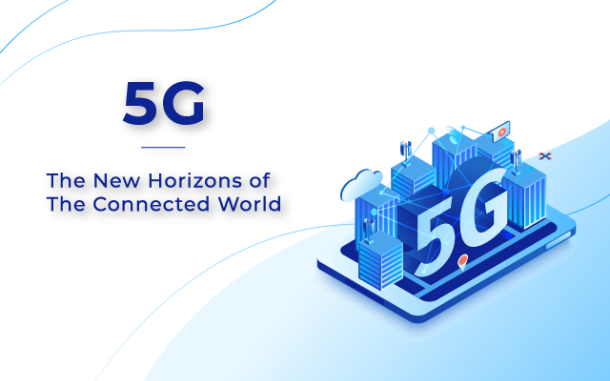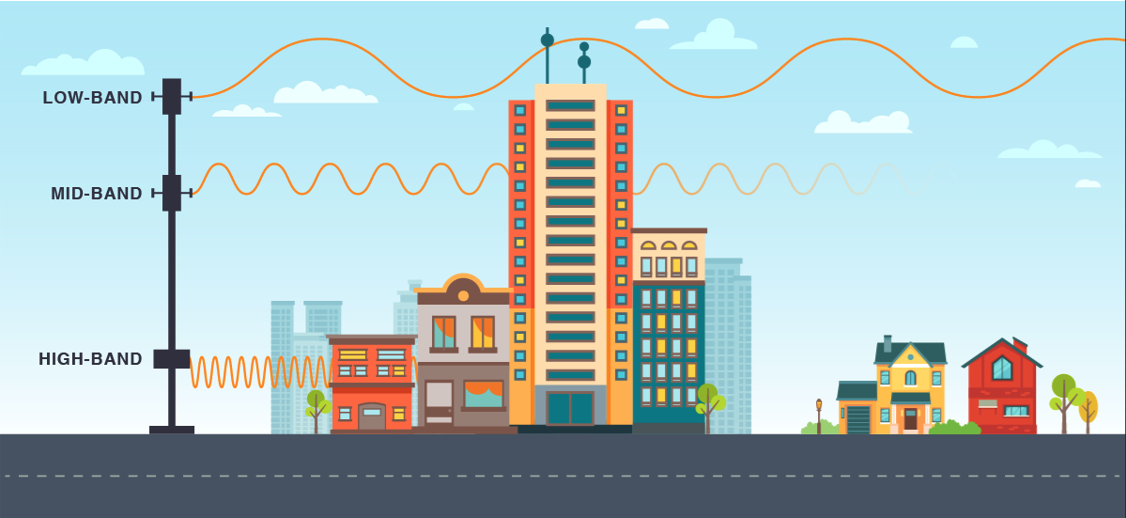5G Networks | The New Horizons of The Connected World

The world's digital connections are about to be transformed with the next generation of wireless connectivity, 5G. This disruptive technology pushes the connectivity barrier for next-gen technologies such as AI, IoT, AR, and VR into new opportunities for new benefits. Additionally, the economic potential of 5G technology in 2035 will enable $13.2 trillion of global economic output based on IHS Markit (2019) report on how 5G will contribute to the global economy. That said, further, in this blog, we will dive deeper into the importance of 5G technologies and their key benefits for a new era of data processing and connectivity.
What is 5G?
5G is the fifth-generation wireless connectivity that would make digitalization more accessible for businesses, public services, and individual households to reap the benefits of IoT, industry 4.0, and the explosion of intelligent devices. The next generation of wireless connectivity, or 5G, acts as a catalyst that promotes the advancement of intelligent connectivity. With speeds up to 100x faster than 4G LTE, 5G networks offer unlimited mobile broadband, low latency, ultra-high reliability, and massive machine-to-machine communications. These significant advancements will impact every industry and bring connectivity and wireless performance to an unprecedented level.
Background of 5G
Mobile cellular networks have long evolved since the first-generation mobile broadband (1G) was developed in the 1980s. Today, wireless cellular technology has become more prominent than ever in its role to connect various devices behind the fabric of interconnected frameworks ever so seamlessly.
Evolution of mobile broadband wireless connectivity:
- The 1980s 1G: First Gen delivered analog voice <30 kHz, 2.4 Kbps speed, and 1s latency.
- The 1990s 2G: Second Gen introduced digital voice and simple data transfer with <200 KHz spectrum, 64 Kbps speed, and 300 – 1000ms latency (eg, CDMA).
- 2000s 3G: Third Gen, brought mobile broadband with <20 MHz spectrum, 2 Mbps speed, and 100 – 500ms latency (eg, CDMA2000).
- The 2010s 4G LTE: Fourth Gen Long Term Evolution is a faster and better mobile broadband than 3G with <100 MHz spectrum, 100 Mbps speed, and 50ms latency.
- The 2020s 5G: fifth-generation cellular network technology, enhanced mobile broadband with 400 MHz up to 50 GHz, ≥ 1Gbps speed, and 1ms latency.
How does 5G technology work?
5G and other cellular mobile networks such as 4G LTE use radio waves or radio frequency (RF) electromagnetic fields (EMF) to communicate with the base stations. However, 5G utilizes a higher EMF spectrum with higher frequencies. Moreover, 5G uses a new digital technology that enables devices to connect with multiple base stations and antennas simultaneously with multiple targeted beams to provide 5G users with enhanced speed and bandwidth within a wide coverage area. This technology is called Massive MIMO, which stands for Multiple-Input Multiple-Output.
3 Types of 5G Networks:
There are different types of 5G networks. 5G network has a broad EMF spectrum which divides 5G connectivity into three main types based on their radio wave spectrum.

Low-Band 5G:
Low-band spectrum or what is known as "coverage layer or blanket layer" refers to lower radio frequencies under 1 GHz. A 5G low-band cell base station signal can reach hundreds of square miles with around 30-250 Mbps download speed. Most US Carriers installed low-band cell towers with frequencies ranging from 600 to 800 MHz. Low-band 5G is slightly better than 4G LTE with a 20% faster data rate. However, with the wide-area coverage of low-band 5G, carriers can build out the base for IoT and IIoT (Industrial Internet of Things) for nationwide coverage.
Mid-Band 5G:
Mid band 5G, also called "sub-6 GHz," has frequencies ranging from 1 GHz to 6 GHz, which is around six times faster than 4G LTE. Moreover, even though mid-band radio waves offer service within smaller areas than low band 5G, mid-band networks strike a good balance on capacity and coverage. Current mid-band speeds fall in the 125 – 200 Mbps range. However, more advanced technologies such as beamforming will allow the mid-band spectrum to reach 600 – 900 MBps . Beamforming is a specific 5G technology that targets multiple 5G beams with an identical wavelength to avoid signal interference and traffic loss at higher frequencies. This new 5G specific technology is a key benefit in 5G network structures because it will enable targeted use of bandwidth in mission -critical applications leveraging high-frequency spectrum bands.Mid-band cell towers coverage focuses more around metropolitan areas with signals that can go several kilometers in radius, not as far as the low Band, but still further than high band 5G. Compared to US carriers that focus more on low and high Band 5G , the rest of the world is focusing on developing mid-band 5G cellular networks. Mid-Band 5G networks are great for mid-level mobile applications such as high-speed upload and download, augmented reality, and virtual desktops for digital workspaces.Mid-Band 5G networks are great for mid-level mobile applications such as high-speed upload and download, augmented reality, and virtual desktops for digital workspaces.Mid-Band 5G networks are great for mid-level mobile applications such as high-speed upload and download, augmented reality, and virtual desktops for digital workspaces.
High-Band 5G (mmWave):
High-band, 5G millimeter-wave (mmWave) frequency bands are ten times faster than 4G LTE networks. The 5G mmWave spectrum ranges from 24-50 GHz, which offers gigabit-per-second (Gbps) rates with a potential to reach 10 Gbps of data rates. The characteristics of mmWave are ultra-fast performance and low latency, but it also has a short coverage of just over one kilometer. Moreover, higher frequency radio waves are unable to penetrate solid objects such as buildings, glass, and foliage which can be a drawback or a benefit. In some cases, this can be a benefit for keeping a confined, private, and secure 5G network in a smart factory, as an example. Most of the high-band 5G cellular towers will be available around dense urban areas like stadiums, convention centers, and shopping malls. In today's real-world applications,the mmWave 5G network has a real-world speed rate between 1-3 Gbps when you are near one of the mmWave cell towers. Some companies like Samsung and Qualcomm raised the standard even higher with a peak speed over 7 Gbps on high-band 5G mmWave.

What is the difference between 5G and 4G?
Previously, the 4G or 4G LTE network has enabled high-quality video streaming and calling on wireless mobile devices with its enhanced speed and bandwidth compared to the third-generation cellular network (3G). However, 4G networks have become a bottleneck for the increasingly complex and data-driven applications that require real-time, low-latency connectivity. But with 5G high-frequency mm waves, the ability for massively scalable connectivity can be possible with the performance benchmarks from 5G performance. In addition, with the new interface technologies, frequencies, and spectrum it uses, 5G has multiple advantages over the previous 4G: higher broadband, low-latency, massive machine-to-machine communication, higher security, and improved energy efficiency.
Five key functional drivers of 5G for connected, intelligent applications:

1. Enhanced mobile broadband (eMBB), Superfast Broadband
5G enhanced mobile broadband refers to faster data rates (up to 10 Gbps), higher throughput, more capacity, and wide coverage areas. In addition, 5G network eMBB will be instrumental in improving various functions, including ultra-HD and 360° video streaming , AR, and VR.
2. Ultra-reliable low latency communication (uRLLC)
Ultra-reliable, low-latency communication refers to the increased speed and quality of the network for mission-critical applications that require uninterrupted, real-time data exchange without compromising the connection reliability. For instance, compared to 4G, 5G network's uRLLC reduced the latency time from 20ms down to <1ms with 99.999% reliability. This provides a crucial real-time experience for applications such as autonomous driving, robot-enabled remote surgery, and factory automation.
3. Massive machine-type communications (mMTC)
5G also supports massive machine-to-machine-type communications that enable the connection to a large number of machines and devices in a wide area that involves the generation, transmission, and processing of data with zero human intervention. With massive multiple-input multiple -output (MIMO) and beamforming, mid-band to high-band 5G network will benefit from a big boost with a 100-fold increase in the number of connections at once. This key 5G benefit provides a huge potential for industrial IoT applications where sensors, devices, and robotics can communicate together for autonomous actions. As a result, some of the most promising applications that will benefit from 5G networks will begin with manufacturing and factory automation, where sensors and devices communicate in real-time in a closed private network environment.
4. Privacy and Security
Another critical driver that increases companies' interest in 5G is the improved privacy and security of the 5G network. Companies can build private 5G networks for their own applications. For instance, by creating a private network in a smart factory, companies can take full advantage of 5G network eMBB, uRLLC, and mMTC. While having more precise network controls of their connected assets and applications can help increase the security from an external attacker that targets and exploits the vulnerability of the public network. In addition, since 5G mmWave spectrum bands are unable to pass through solid objects, attackers need to enter the facility to access the company's private network.
5. Power Efficiency, high reliability/availability, and efficient energy use
Despite the robust performance of 5G networks, it will offer better energy consumption and lower costs compared to previous cellular network generations. Connected 5G devices will intelligently detect how to control their energy usage during the active or idle state. 5G is capable of decreasing 90% of the core network consumption by allocating energy usage in an efficient manner.
5G Pushes Industrial 4.0 Technologies to realize Their Full Potential
The potential of 5G will fully transform a myriad of applications within the industrial 4.0 economy with unprecedented levels of connectivity. 5G networks will help to realize the full potential of Industrial 4.0 benefits. It will enhance various intelligent technologies such as artificial intelligence, IoT, advanced data analytics, cloud computing, drones, 3D printing, robotic process automation, and more; all applications require low latency for real-time processing and immediate decision-making.
Learn More About AIoT and The Future Of Industrial 4.0
Some of the market sectors that will take advantage of 5G:

Within the following industries, 5G will significantly contribute in many different ways: from enabling faster processing, improving workplace safety, increasing operational effectiveness, and lowering the factory's carbon footprint.
- Smart City – Intelligent Buildings and Infrastructure
- Smart Manufacturing – Industrial Automation
- Healthcare – IoMT (Massive Internet of Medical Things)
- Kiosk and Retail – Enhanced AR, VR, and Wearable Devices
- Energy and Utility – Smart-Grid Control and Predictive Intelligence
- Automotive Industry – Intelligent Transporation and Autonomous Driving
- Security – Public Safety & Surveillance
The next generation of cellular networks or 5G will eventually take over the realm of mobile connectivity, similar to 4G LTE and its predecessor, 3G. However, the impact of 5G will be much more significant than any other wireless technology, with a prediction to be worth $13.2 trillion by 2035, according to IHS Markit (2019). As a result, the digitalization of the data and the service industry will undergo a massive catalyst where most applications can benefit. Hence, it's pivotal for businesses to keep developing their solutions with the latest technological trends increasingly to stay relevant and competitive within the competitive industry for the digitization of data. To check out more about 5G-ready industrial computing solutions, visit C&T Solution.com for the most robust,rugged computing technologies for your extreme industrial deployments.

Reference List:
IHS Markit. (2019, November). The 5G Economy | How 5G will contribute to the global economy.

